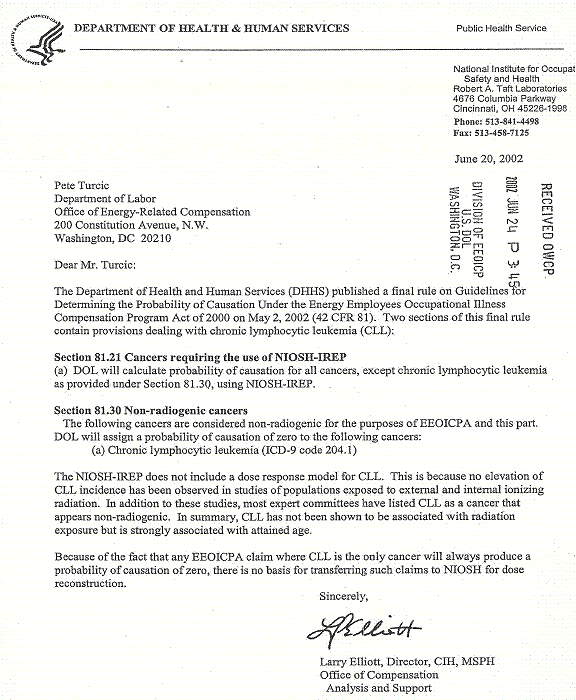The EEOICPA was passed in 2000. It provides compensation to workers who became ill as a result of their employment manufacturing nuclear weapons in the USA, as well as their spouses, children, and grandchildren.
Are you eligible for compensation? If you or a family member worked at any of the Atomic Weapons Employer (AWE) and Department of Energy (DOE) Covered Facilities listed on this website and became ill, you may be entitled to compensation of up to $400K plus medical benefits. Call EEOICPA Counsel Hugh Stephens at 1-855-548-4494 or fill out our free claim evaluation, We can help even if you’ve already filed, even if your claim was denied!
In these pages, we present general definitions of Illnesses covered by the Act, followed by specific references to the disease from the EEOICPA Procedure Manual, Bulletins, and Final Decisions of the Final Adjudication Board to clarify how these maldies might relate to the Energy Employees Occupational Illness Compensation Program Act.
Leukemia
Leukemia is a type of blood cancer that begins in the bone marrow. Leukemia is one of the 22 Specified Cancers covered by the Special Exposure Cohort (SEC) classes of the EEOICPA. If you, or a family member has a condition or died due to possible exposure or radiation, then you might be eligible for up to $400,000. Submit your free claim evaluation now!
The most common forms of leukemia that are covered by EEOICPA are described on our blog. Here, we have collected specific references to leukemia from the DEEOIC including:
- Bulletins
- Procedure Manual
- Final Decisions
These will illustrate how Leukemia is viewed under the EEOICPA.
Please Note: In order to preserve historical accuracy, this page retains the letter from NIOSH’s Department of Health an Human Services dated June 20, 2002 which categorizes Chronic Lymphocytic Leukemia (CLL) as a non-radiogenic cancer that automatically registers a zero probability of causation (POC) and so requires no dose reconstruction, as well as the Procedure Manual entry that echoes that determination. Both documents, however, are superseded by EEOICPA BULLETIN NO. 12-01 of March 7, 2012 which rescinds that designation and calls for dose reconstructions to be performed on claims where the Covered Illness is CLL.
*Further Note: Page numbers below refer to the documents available on our DEEOIC Resources page.
Bulletins
Page 10
12-01 Chronic Lymphocytic Leukemia (CLL) as a Radiogenic Cancer under the Energy Employees Occupational Illness Compensation Program Act (EEOICPA)
EEOICPA BULLETIN NO. 12-01
Issue Date: March 7, 2012, Effective Date: March 7, 2012, Expiration Date: March 7, 2013
Subject: Chronic Lymphocytic Leukemia (CLL) as a Radiogenic Cancer under the Energy Employees Occupational Illness Compensation Program Act (EEOICPA).
Background: The Department of Health and Human Services (HHS) develops guidelines, by regulation, to be used by the Division of Energy Employees Occupational Illness Compensation (DEEOIC) to assess the likelihood that a worker with cancer developed that cancer as a result of exposure to radiation in performing his or her duty at a Department of Energy (DOE) facility or an atomic weapons employer facility. The guidelines are published in 42 C.F.R. Part 81, and comprise a set of policies and procedures by which DEEOIC determines whether it is “at least as likely as not” that the cancer of an employee was caused by radiation doses the employee incurred while employed at a covered facility. Currently, CLL is designated as a non-radiogenic cancer, which required DEEOIC to assign a probability of causation value of “zero.” On February 6, 2012, HHS published a final rule removing that designation. Therefore, effective March 7, 2012, claimants with CLL will be eligible for radiation dose reconstruction under the EEOICPA.
References: 42 C.F.R. Part 81.
Purpose: To provide procedures on processing claims for CLL.
Applicability: All staff.
Actions:
- This bulletin addresses claims previously denied, claims pending adjudication (including those at NIOSH), and claims yet to be submitted.
- The DEEOIC will prepare a comprehensive list of cases (to include those cases identified by NIOSH) with a diagnosis of CLL (ICD-9 code 204.1 through 204.19). The list includes all cases with a non-approved CLL diagnosis. All cases on the list must be reviewed by the district office(s) and by the Final Adjudication Branch (FAB) to ensure that it is referred to NIOSH for a dose reconstruction or rework of the dose reconstruction, where appropriate. The comprehensive list will be provided to the district offices and FAB under separate cover.
- For all cases on the comprehensive list that were previously denied with a “zero” percent probability of causation value assigned to the CLL, the claim for CLL is to be reopened. In the exercise of the DEEOIC Director’s discretion in the reopening process, the Director is delegating limited authority to the four District Directors (DD) and the Assistant District Directors (ADD), to sign Director’s Orders for reopening of all CLL related cases. This delegated authority is limited to reopening those cases that appear on the comprehensive list. If the DD or ADD identifies a case that is not on the comprehensive list but has a diagnosis of CLL (with an ICD-9 code referenced in the previous paragraph), the case should be referred to the National Office. A sample Director’s Order is provided in Attachment 1. The Director is retaining sole signature authority for all other types of reopenings not otherwise delegated. Once a Director’s Order is issued, the district office is responsible for any further development and issuance of a new recommended decision.
- Upon reopening the claim for CLL, the district office is to refer the case to NIOSH for a dose reconstruction or rework of the dose reconstruction, as appropriate. When referring these cases to NIOSH for further analysis, a request to the National Office Health Physicist is not required. Instead, the CE should prepare a NIOSH Referral Summary Document (NRSD) or Amended NIOSH Referral Summary Document (ANRSD), as appropriate, and forward the NRSD or ANRSD to the Public Health Advisor (PHA) assigned to the district office at NIOSH. The referrals to NIOSH should be conducted in accordance with EEOICPA Procedure Manual Chapter 2-0900 and must be recorded in ECS using the NIOSH causation path.
- For those claims where the dose reconstruction yields a combined probability of causation (PoC) of less than 50%, the district office is to issue a new recommended decision addressing CLL only. However, should the dose reconstruction yield a combined PoC of 50% or greater, the district office will reopen all cancers that were previously denied based on the PoC in accordance with Action Item #3. The district office will then issue a new recommended decision addressing all cancers.
- For cases currently pending a final decision at the FAB with a less than 50% PoC, the Hearing Representative/Claims Examiner (CE) is to remand the recommended decision to the district office in the usual manner. The Remand Order should direct the district office to refer the case to NIOSH for a dose reconstruction or rework of the dose reconstruction as a result of the designation of CLL as a radiogenic cancer. Once the case is remanded, the district office is to refer the case to NIOSH as instructed in Action Item #4.
- For those cases currently at NIOSH that have CLL, DEEOIC has been notified that NIOSH will conduct the dose reconstruction to include the CLL.
- Upon receipt of the dose reconstruction report from NIOSH, the CE proceeds in the usual manner and prepares a recommended decision.
Disposition: Retain until incorporated in the Federal (EEOICPA) Procedure Manual.
RACHEL P. LEITON
Director, Division of Energy Employees
Occupational Illness Compensation
[divider height=”30″ style=”default” line=”default” themecolor=”1″]
Page 733
03-24 Probability of Causation Instructions for Certain Special Circumstances
EEOICPA BULLETIN NO.03-24
Issue Date: May 2, 2003, Effective Date: May 2, 2003, Expiration Date: May 3, 2004
7. For leukemia cases, NIOSH will provide dose reconstruction results for all of the leukemia models, as applicable. Following the standard approach, the CE will make the final PoC determination based on the leukemia model that yields the highest PoC.
[divider height=”30″ style=”default” line=”default” themecolor=”1″]
Page 826
02-08 GDP times
EEOICPA BULLETIN NO.02-08
Issue Date: May 7, 2002, Effective Date: May 7, 2002, Expiration Date: May 7, 2003
Subject: Clarification of the onset period for specified cancers and the 250-day employment requirement at a Gaseous Diffusion Plant.
Background: …The second issue addresses the length of time following first exposure to radiation at a GDP until the diagnosis of the employees’ specified cancer. EEOICPA Section 7384l(17) defines specified cancers for inclusion in the SEC. The Act also states that certain onset time requirements need to be met in order to qualify for SEC inclusion. For most cancers, an eligible employee must have developed a specified cancer 5 years after first exposure. In the case of leukemia, an onset time of more than two years after initial occupational exposure is required. There are no delay of onset periods for primary or secondary lung, bone, and renal cancers.
Actions:
5. For leukemia, the CE must determine that the date of diagnosis is greater than two years after initial occupational exposure at the GDP (per EEOICPA Section 7384l(17)).
[divider height=”30″ style=”default” line=”default” themecolor=”1″]
Page 841
02-13 Chronic lymphocytic leukemia
EEOICPA BULLETIN NO.02-13
Issue Date: July 12, 2002, Effective Date: June 20, 2002, Expiration Date: June 20, 2003
Subject: Chronic Lymphocytic Leukemia Cases
Background: Section 20 CFR 30.115(a) of the interim final regulations currently provides that the Office of Workers Compensation Programs (OWCP) will refer all non-SEC cancer claims to NIOSH for dose reconstruction before the probability of causation is determined.
On May 2, 2002, the Department of Health and Human Services (HHS) published guidelines (42 CFR 81) OWCP must use to determine the probability of causation for non-SEC cancer claims. Section 81.30 of these guidelines directs OWCP to assign a probability of causation of zero for certain non-radiogenic cancers listed. As of the date of this bulletin, the only non-radiogenic cancer listed by HHS in their guidelines is chronic lymphocytic leukemia (CLL).
Given the HHS guidelines, referring a non-SEC claim for CLL to NIOSH for dose reconstruction serves no useful purpose. Accordingly, an exception to the normal process for determining the probability of causation is needed. The procedures described in this bulletin explain how claims solely for non-radiogenic cancers like CLL are exempt from undergoing a dose reconstruction with NIOSH.
Reference: Interim final regulations 30 CFR 30.115(a) and 42 CFR Parts 81.21 and 81.30.
Purpose: To explain the process for handling Chronic Lymphocytic Leukemia claims.
Applicability: All staff.
Actions:
- Upon review of a new claim for compensation, the CE should identify any instance where (CLL) has been claimed or identified through the review of medical records.
- If CLL has been claimed or otherwise been documented in the case file, the CE should undertake appropriate claim development according to established policy and procedure. The evidence of record must be sufficient to establish the necessary medical and employment components for any covered claim under the program.
- Once steps have been taken to establish a diagnosis of CLL and covered cancer employment, the CE must insert in the case file a letter from NIOSH (Attachment 1). This letter will serve as the dose reconstruction for all instances of CLL.
- The CE must then assess whether any other covered cancer has been established in the case records.
- If the CE determines that a diagnosis of CLL exists in conjunction with another type of cancer, a NIOSH referral summary should be prepared. The CE should reference CLL as a diagnosed cancer along with any other cancer established in the case record. The referral summary should then be sent to NIOSH.
- NIOSH will conduct the dose reconstruction on each cancer aside from CLL and provide the dose reconstruction report. In determining the probability of causation, the CE must apply the results of the dose reconstruction for all established cancers except CLL in the IREP. Given the outcome of the probability of causation calculation, the CE should then prepare a recommended decision including separate findings for each claimed cancer. The CE should include a finding in the recommended decision that explains that the diagnosis of CLL was valid, but given the HHS published guidelines, it has been assigned a probability of zero and, as such, the condition is denied from coverage under the program. The CE should cite the appropriate regulations pertaining to this finding. In particular, the CE should cite 42 CFR 81.30.
- If the CE determines that CLL is the sole cancer established, it is not necessary to prepare a NIOSH referral summary or to refer the case record to NIOSH. As NIOSH has identified CLL as a non-radiogenic cancer, a dose reconstruction is unnecessary. Once this determination is made, the CE should input claim adjudication code “NR” (NIOSH Dose Reconstruction Received) in ECMS. For the IREP Version entry, the CE should list “N/A.”
- The CE should then prepare a recommended decision denying compensation benefits for the reason that per NIOSH regulations, the diagnosis of CLL has a zero probability of causation. The CE should cite the appropriate regulations for this finding in the recommended decision.
- NIOSH has prepared a list of case files presently undergoing review for dose reconstruction that contain references to CLL. This list will be presented to the District Office (DO) under separate cover. The list identifies claim records where CLL is the sole condition claimed. In addition, it identifies case records that contain some sort of discrepancy concerning CLL. Each DO is to review this list to determine the case records for which they are responsible.
- If the DO reviews the list and finds a case record where CLL is the only diagnosed condition, a letter is to be prepared to NIOSH. The letter should explain the finding of the DO and advise that a dose reconstruction is unnecessary. NIOSH should also be advised to return all case file records. The DO may then proceed with the issuance of a recommended decision denying benefits given the diagnosis of CLL.
- If NIOSH has identified a discrepancy in the medical evidence pertaining to a diagnosis of CLL, the DO should examine the case file to determine what corrective action is necessary. In some instances, the CE merely has to ensure that the appropriate ICD-9 code has been applied to a diagnosed CLL. Once this action would be completed, the CE can prepare a letter to NIOSH noting the corrective action taken by the CE and stating whether a dose reconstruction is necessary. Other discrepancies noted by NIOSH may require additional development of the evidence by the CE. If this is the situation, the CE should prepare a letter to NIOSH advising that no further action on the dose reconstruction should occur until clarification is provided. The CE should then take whatever steps are necessary to resolve the factual or medical discrepancies raised by NIOSH. Once any outstanding issue has been resolved, NIOSH should be advised of the outcome and whether to proceed with a dose reconstruction.
Disposition: Retain until incorporated in the Federal (EEOICPA) Procedure Manual
PETER M. TURCIC
Director, Division of Energy Employees
Occupational Illness Compensation
Distribution List No. 1: Claims Examiners, Supervisory Claims Examiners, Technical Assistants,
Customer Service Representatives, Fiscal Officers, FAB District Managers, Operation Chiefs,
Hearing Representatives, District Office Mail & File Sections
Procedure Manual
Page 47
uu. Specified Cancers are listed in Section 30.5(ff) of the regulations. An employee must be diagnosed with one of these specific types of cancer to be considered eligible for benefits as a member of the Special Exposure Cohort (SEC). The list of specified cancers, which is derived from section 4(b)(2) of the RECA Amendments of 2000, is as follows:
4. Leukemia (other than chronic lymphocytic leukemia), only if onset occurred more than two years after initial occupational exposure;
Page 175
7. Specified Cancers: In addition to satisfying the employment criteria under a SEC class, the employee must also have been diagnosed with a specified cancer to be eligible for compensation under the SEC provision. The following are specified cancers in accordance with 20 C.F.R. § 30.5(ff):
a. Leukemia. [Chronic lymphocytic leukemia (CLL) is excluded]. The onset must have occurred at least two years after initial exposure during qualifying SEC employment.
Page 265
HHS Chronic Lymphocytic Leukemia Guideline Letter
Once the CE has determined that the employee has a diagnosed non-SEC cancer (other than chronic lymphocytic leukemia (CLL)) and covered employment, the claim must be referred to the National Institute for Occupational Safety and Health (NIOSH) for a dose reconstruction to determine the PoC between the diagnosed non-SEC cancer and the dose potentially received during the covered employment. If CLL is the only diagnosed cancer, the CE does not send the case to NIOSH because NIOSH has identified CLL as a non-radiogenic cancer. However, the CE must still develop CLL for toxic substance exposure if there is a claim under Part E. Refer to paragraph 17i for further handling.
Page 257 ff.
17. Proving Causation Between Diagnosed Non-SEC Cancer and Covered Employment. Under Part B, a covered employee seeking compensation for cancer, other than as a member of the SEC seeking compensation for a specified cancer, is eligible for compensation only if DOL determines that the cancer was “at least as likely as not” (that is, a 50% or greater probability) caused by radiation doses incurred in the performance of duty while working at a DOE facility and/or an Atomic Weapons Employer (AWE) facility.
This includes radiation doses from medical X-rays for the pre-employment physical examination, annual physical examinations, and a termination (exit) physical examination, but does not include radiation to which the employee may have been exposed during airline flights, as such exposures are not incurred from activities at the sites.
EEOICPA does not include a requirement limiting the types of cancers to be considered radiogenic; CLL is considered non radiogenic pursuant to HHS regulation.
h. Claims for Leukemia. Sometimes NIOSH guidance requires that two or three NIOSH-IREP models be run for a particular cancer. This most often occurs with different types of leukemia. NIOSH only includes the NIOSH-IREP input and associated summary sheet providing the highest PoC in the “DR Files” on the disk sent to the DO.
i. Claims for Chronic Lymphocytic Leukemia(CLL) Only. CLL is a form of leukemia not found to be radiogenic in studies conducted worldwide of a wide variety of radiation-exposed populations. Therefore, pursuant to HHS regulations, the PoC for CLL is assigned a value of zero. The CE will insert Exhibit 9 into the file for the record. Exhibit 9 is a letter from NIOSH that states the Department of Health and Human Services (HHS) guidelines for determining the PoC for CLL. Since CLL has a PoC of zero, the CE adjudicates the claim without sending the case to NIOSH. The RD must contain a reference to the DHHS regulations and cite 42 C.F.R. § 81.30 denying compensation benefits under Part B of the Act.
(1) In cases where there are multiple primary cancers including CLL, and the PoC is greater than 50%; medical benefits will be covered for CLL. When CLL is diagnosed after an award has been made for a greater than 50% PoC, medical benefits are paid for CLL.
(2) CLL may be compensable under Part E of the Act. The CE must determine if causation can be established for CLL and exposure to toxic substances other than radiation under Part E.
Page 293
c. Section 4 of RECA.
(1) Downwinders.
(a) Coverage: Individuals who were physically present in one of the affected areas downwind of the Nevada Test Site during a period of atmospheric nuclear testing, and later developed a covered illness.
(b) Covered Illnesses: Leukemia (other than chronic lymphocytic leukemia), multiple myeloma, lymphomas (other than Hodgkin’s disease), and primary cancer of the thyroid, male or female breast, esophagus, stomach, pharynx, small intestine, pancreas, bile ducts, gall bladder, salivary gland, urinary bladder, brain, colon, ovary, liver (except if cirrhosis or hepatitis B is indicated), or lung.
(c) Benefits Payable by DOJ: A payment of $50,000 is available to eligible individuals.
EEOICPA: Final Decisions
Page 1:
EEOICPA Fin. Dec. No. 2158-2003 (Dep’t of Labor, July 11, 2008)
NOTICE OF FINAL DECISION FOLLOWING A HEARING
This is the decision of the Final Adjudication Branch (FAB) concerning your claim for survivor benefits under Part B of the Energy Employees Occupational Illness Compensation Program Act of 2000, as amended (EEOICPA), 42 U.S.C. § 7384 et seq. For the reasons set forth below, your claim for survivor benefits based on acute myelocytic leukemia (acute myelomonocytic leukemia) is denied.
STATEMENT OF THE CASE
On August 7, 2001, you filed a claim for survivor benefits under Part B of EEOICPA, Form EE-2, as the spouse of [Employee], hereinafter referred to as the employee. On July 31, 2002, you also filed a claim for assistance under Part D of EEOICPA with the Department of Energy (DOE). You identified acute myelocytic leukemia (acute myelomonocytic leukemia) as the medical condition of the employee resulting from his employment at an atomic weapons facility.
On Form EE-3 you indicated that the employee worked as a laboratory technician for Lucius Pitkin at the Allied Chemical facility in Metropolis, Illinois from July 1978 to July 1985. The Allied Chemical Corporation Plant in Metropolis, Illinois is a covered atomic weapons employer (AWE) facility from 1959 to 1976 and covered for residual radiation contamination from 1977 to July 2006.[1]
On February 28, 2003, DOE denied your claim for assistance under Part D, because the employee’s work at the Allied Chemical Corporation Plant was at an AWE rather than a DOE facility. On April 14, 2003, the FAB issued a final decision denying your claim for survivor benefits under Part B because the employee did not have covered employment under the EEOICPA. The FAB found that the employee’s period of employment at the Allied Chemical Corporation Plant was outside the covered years for that facility.
Thereafter, on October 28, 2004, Congress repealed Part D of EEOICPA and enacted new Part E. Because of this, DEEOIC proceeded to adjudicate your Part D claim under Part E and on May 17, 2006, the FAB issued a final decision denying your claim for survivor benefits under Part E because the employee was not employed by a DOE contractor at a DOE facility. As part of the 2004 amendments to EEOICPA, Congress amended the definition of an “atomic weapons employee” to include employees of subsequent owners or operators of an AWE facility beyond the time period during which weapons-related work occurred, provided that the National Institute for Occupational Safety and Health (NIOSH) had found that there was the potential for residual radiation contamination at the facility. NIOSH subsequently determined that the Allied Chemical Corporation facility had the potential for residual radiation contamination from 1977 to July 2006. This period of residual contamination resulted in the covered period at this particular facility being expanded.
On June 5, 2007, the Director of the Division of Energy Employees Occupational Illness Compensation (DEEOIC) issued a Director’s Order vacating the FAB’s April 14, 2003 final decision and reopening your claim for benefits under Part B. This order instructed the district office to determine if the employee’s employment by Lucius Pitkin at the Allied Chemical Corporation facility qualified as employment by a “subsequent owner or operator” at that AWE facility under Part B of EEOICPA. As part of this further development, the district office received a June 20, 2007 letter from I. Boyarsky, the controller of Lucius Pitkin, Inc., in which he indicated that Lucius Pitkin, Inc. was hired as an independent observer at the facility to weigh and sample ore and was never a co-owner nor operator of the Allied Chemical Corporation facility.
On July 17, 2007, the district office issued a recommended decision to deny your claim for benefits under Part B because the employee was not employed by Allied Chemical or by a subsequent owner or operator of the Allied Chemical Corporation facility, and thus his employment was not covered under EEOICPA. On August 6, 2007, you objected to the recommended decision and attached a copy of the Director’s Order. On August 20, 2007, the FAB issued a remand order returning your claim to the district office with instructions to refer the case file to the Branch of Policies, Regulations and Procedures (BPRP) within DEEOIC for a determination on whether the employee’s work with Lucius Pitkin, Inc. at the Allied Chemical Corporation facility qualified him as an atomic weapons employee under Part B of EEOICPA. Pursuant to that remand order, the district office referred your case file to the BPRP. On November 26, 2007, the BPRP determined that the employee’s employment with Lucius Pitkin, Inc. at the Allied Chemical Corporation facility did not qualify him as an atomic weapons employee because Lucius Pitkin, Inc. was not a subsequent owner or operator of that AWE facility.
On December 13, 2007, the district office issued another recommended decision to deny your claim for survivor benefits under Part B of EEOICPA, on the ground that the employee’s employment by Lucius Pitkin, Inc. at the Allied Chemical Corporation facility did not qualify him as an “atomic weapons employee,” as that term is defined in EEOICPA. Accompanying the recommended decision was a letter explaining your rights and responsibilities in regard to the recommended decision.
OBJECTIONS
On January 14, 2008, the FAB received your January 8, 2008 letter objecting to the recommended decision and requesting a hearing to air your objections, which was held on March 19, 2008 in Mount Vernon , Illinois. You and Virginia Griffey were present at this hearing and presented testimony.
Your objections to the recommended decision are summarized below:
- Objection No. 1: You indicated that the employee worked for Lucius Pitkin, Inc. but worked at the Allied Chemical Corporation facility, and because he was checking the moisture content of the dry uranium, which was an activity that was vital to the operation of the plant, then his employment should be covered because he should be considered an operator of the facility.
- Objection No. 2: You indicated that Allied Chemical supplied the employees of Lucius Pitkin, Inc. with clothing, gloves, hard-hats and shoes, laundered their clothing and provided and maintained the respirators used by both Allied Chemical and Lucius Pitkin, Inc. employees.
- Objection No. 3: You indicated that the employee’s doctors advised that the employee’s cancer was caused by him handling raw uranium.
- Objection No. 4: You indicated that it is unfair to compensate employees of the United States Enrichment Corporation (USEC) who worked at the Paducah Gaseous Diffusion Plant or Allied Chemical Company employees who worked in the same building as the employee, had the same exposures as the employee and who also contracted cancer, but not to compensate the employee merely because he was not working for a covered employer.
Your first objection concerns whether the employee’s work duties qualified him as an operator of thisfacility. The EEOICPA provides that an “atomic weapons employee” includes an individual who was employed by an AWE during a period when the employer was processing, or producing, for the use by the United States, material that emitted radiation and was used in the production of an atomic weapon, excluding uranium mining and milling. It also includes an individual employed by an AWE or subsequent owners or operators of an AWE facility during a period of significant residual radiation contamination outside of the period in which weapons-related production occurred. See 42 U.S.C. § 7384l(3).
The period of the employee’s employment at this AWE facility is not during the period when weapons-related production occurred; however, it was during the residual radiation period when employees of the AWE, or subsequent owners or operators of the facility, are covered. There is no evidence that the employee was employed by the Allied Chemical Corporation or a subsequent owner or operation of this AWE facility. The employee was working for Lucius Pitkin, Inc. and his duties at the Allied Chemical Corporation facility were performed pursuant to a contract between the Allied Chemical Corporation and Lucius Pitkin, Inc. The controller of Lucius Pitkin, Inc. has confirmed that Lucius Pitkin, Inc. was not an operator or subsequent owner of the Allied Chemical Corporation facility. The determination of whether a contractor of an AWE is an owner or operator of an AWE facility is not based on the duties performed by an individual employee, but rather by the nature of the contract. The evidence of record does not establish that the employee worked for an AWE, a subsequent owner of the AWE facility or for a company that was contracted to operate this facility.
Your second objection concerns whether the employee should be considered an employee of Allied Chemical Corporation for purposes of EEOICPA. When it enacted EEOICPA, Congress provided specific criteria that must be met to establish that an individual qualifies as an “atomic weapons employee” in § 7384l(3). Those criteria do not include employees of contractors or subcontractors of an AWE, employees of wholly-owned subsidiaries of an AWE, or employees who are considered “shared,” “on loan,” “borrowed servants,” or “statutory employees.” See EEOICPA Fin. Dec. No. 4894-2004 (Dep’t of Labor, March 8, 2005); EEOICPA Fin. Dec. No. 366-2002 (Dep’t of Labor, June 3, 2003); EEOICPA Fin. Dec. No. 13183-2003 (Dep’t of Labor, October 14, 2003). The evidence of record simply does not establish that the employee worked for an AWE. The Department of Labor must administer EEOICPA as enacted by Congress and cannot alter the necessary criteria to qualify as an atomic weapons employee under EEOICPA.
Your third objection concerns the cause of the employee’s cancer. EEOICPA provides benefits for specific occupational illnesses like cancer for an employee (or his survivors) who is considered to be a “covered employee with cancer.” See 42 U.S.C. §§ 7384l(9), 7384n. The cause of an employee’s cancer does not determine if that employee has covered employment. The evidence of record does not establish that the employee had any employment that was covered under EEOICPA.
Your fourth objection concerns the distinguishing criteria set out by Congress that are prerequisites to qualify for benefits based on cancer for atomic weapons employees, DOE employees working at covered DOE facilities, or DOE contractor or subcontractor employees working at covered facilities under EEOICPA. The Department of Labor has no authority to alter those sDistribution List No. 1tatutory criteria.
EEOICPA regulations place the burden of establishing covered employment upon the claimant. You have not submitted evidence that establishes that the employee has covered employment under EEOICPA.
After reviewing the evidence of record in your claim file forwarded by the district office, I hereby make the following:
FINDINGS OF FACT
- You filed a claim for survivor benefits under Part B of EEOICPA on August 7, 2001 as the spouse of the employee.
- You alleged that the employee worked for Lucius Pitkin, Inc. at the Allied Chemical Corporation facility from July 1978 to July 1985.
- The Allied Chemical Corporation facility is an AWE facility from 1959 to 1976, and also covered for residual radiation contamination from 1977 to July 2006.
- Lucius Pitkin, Inc. is not an AWE, a subsequent owner of the Allied Chemical Corporation facility, or a subsequent operator of that AWE facility.
- You have not submitted evidence that the employee was employed by an AWE at an AWE facility, or that the employee worked for DOE or for a DOE contractor or subcontractor at a DOE facility.
Based upon these facts, the undersigned makes the following:
CONCLUSIONS OF LAW
Part B of EEOICPA provides benefits to covered employees working at covered facilities who sustain an “occupational illness” as a result of exposure during the performance of duty at those facilities. See 42 U.S.C. §§ 7384l(1), 7384n and 7384s. In order to claim benefits under Part B of EEOICPA for cancer, the evidence must establish that the employee was either a DOE employee or a DOE contractor employee working at a DOE facility, or an atomic weapons employee working at an AWE facility who contracted cancer due to exposure to radiation in the performance of duty. See 42 U.S.C. §§ 7384l(9), 7384n and 7384s.
You claimed that the employee contracted cancer as a result of his employment at the Allied Chemical Corporation facility. However, EEOICPA sets out specific criteria for an employee to qualify as an “atomic weapons employee.” An “atomic weapons employee” is defined an individual who was employed by an AWE during a period when the employer was processing or producing, for the use by the United States, material that emitted radiation and was used in the production of an atomic weapon, excluding uranium mining and milling. It is also defined as an individual employed by an AWE or a subsequent owner or operator of an AWE facility during a period of significant residual radiation contamination outside of the period in which weapons-related production occurred. 42 U.S.C. § 7384l(3). Further, EEOICPA defines an “an atomic weapons employer” as an entity (other than the United States) that processed or produced for use by the United States, material that emitted radiation and was used in the production of an atomic weapon, excluding uranium mining and milling, and is designated by the Secretary of Energy as an AWE for the purposes of EEOICPA. 42 U.S.C. § 7384l(4). The term “atomic weapons employer facility” means a facility owned by an AWE that is or was used to process or produce, for use by the United States, material that emitted radiation and was used in the production of an atomic weapon, excluding uranium mining or milling. 42 U.S.C. § 7384l(5).
A determination regarding your entitlement to benefits must be based on the totality of the evidence. You indicated that the employee worked at the Allied Chemical Corporation facility. That facility is a covered “atomic weapons employer facility” as defined by 42 U.S.C. § 7384l(5). You claimed that the employee worked for Lucius Pitkin, Inc. However, Lucius Pitkin, Inc is not an AWE because it has not been designated as such by the Secretary of Energy, nor is it a subsequent owner or operator of the Allied Chemical Corporation facility. Therefore, the employee does not qualify as an “atomic weapons employee” because he was not employed by an AWE during a period when that employer was processing or producing, for the use by the U.S., material that emitted radiation and was used in the production of an atomic weapon, nor was he employed by a subsequent owner or operator of the AWE facility during a period of residual radiation contamination. I have reviewed the evidence of record and it does not establish that the employee has employment covered under EEOICPA.
Section 30.110(c) of the EEOICPA regulations provides that any claim that does not meet all of the criteria for at least one of the categories including a “covered Part B employee” (as defined in § 30.5(p)) set forth in the regulations must be denied. See 20 C.F.R. §§ 30.5(p), 30.110(b), and 30.110(c). As you have not established that the employee is a covered Part B employee (because the evidence does not establish that the employee worked for an AWE), your claim for survivor benefits based on the employee’s acute myelocytic leukemia (acute myelomonocytic leukemia) under Part B of EEOICPA must be denied.
Washington D.C.
William J. Elsenbrock
Hearing Representative
Final Adjudication Branch
[divider height=”30″ style=”default” line=”default” themecolor=”1″]
Page 97
EEOICPA Fin. Dec. No. 13183-2003 (Dep’t of Labor, October 15, 2003)
NOTICE OF FINAL DECISION FOLLOWING A HEARING
This is the decision of the Final Adjudication Branch (FAB) concerning your claim for compensation under the Energy Employees Occupational Illness Compensation Program Act of 2000, as amended, 42 U.S.C. § 7384 et seq. (EEOICPA or the Act). For the reasons discussed below, your claim for compensation is denied.
STATEMENT OF THE CASE
You filed a claim, Form EE-2, on October 23, 2001, seeking benefits pursuant to the Energy Employees Occupational Illness Compensation Program Act. You indicated on the claim form that you were filing for your spouse’s cancer, specifically, acute myelogenous leukemia, diagnosed approximately on January 1, 1995. You also submitted Form EE-3, employment history, indicating that your spouse was employed by Fercleve Corporation, Manhattan Project, Oakridge, Tennessee, as a project technician from 1944 through 1946. Along with the claim forms, you submitted:
- your spouse’s death certificate, noting the immediate cause of death as Mucormycosis Brain Abcess(s) due to or as a consequence of acute myelogenous leukemia;
- your marriage certificate;
- several listings of prescriptions/medications;
- several listings of medical expenses;
- a copy of your spouse’s honorable discharge certificate dated March 14, 1946;
- a copy of your spouse’s enlisted record and report of separation;
- a copy of a letter to Senator Bunning from [Authorized Representative] dated February 2, 2001;
- a copy of a letter to The Christ Hospital from Philip D. Leming, M.D. dated December 5, 1997;
- a copy of a hematology consultation and admission note signed by Philip D. Leming dated October 2, 1997, noting a diagnosis of acute myelocytic lueukemia with pancytopenia;
- a copy of a Ohio State University James Cancer Hospital and Research Institute medical document signed by Michael A. Caligiuri dated September 10, 1998;
- a copy of a letter signed by Philip D. Leming, M.D dated September 24, 2001, noting that it was at least as likely as not that the patient’s acute leukemia was related to the radiation exposure in the past from his work on the atomic bomb project (Manhattan Project) in Oakridge, TN as any additional exposures;
- a copy of United States of America, War Department Army Service Forces Corps of Engineers Manhattan District certificate that states, “This is to certify that [Employee] Fercleve Corporation has participated in work essential to the production of the Atomic Bomb, thereby contributing to the successful conclusion of World War II. This certificate is awarded in appreciation of effective service.” Signed by the Secretary of War, dated August 6, 1945; On November 15, 2001, the Cleveland, Ohio, district office received a letter from Droder & Miller CO., L.P.A. indicating that on your original application for benefits under the EEOICPA it indicated that your spouse’s diagnosis of cancer was in January of 1995, but Mr. Miller believes the records indicate that the diagnosis was sometime in mid to late 1997.
On February 12, 2002, the Cleveland District Office requested that additional medical evidence be provided within 30 days from the date of the letter. On February 27, 2002, the District Office received a letter from you dated February 25, 2002, stating that your spouse’s diagnosis was 10/97, not 1/95, and that you received only the February 12, 2002, letter from the District Office. You also submitted:
- a duplicate copy of a letter dated September 24, 2001, signed by Philip D. Leming, M.D.;
- a duplicate copy of the Ohio State University James Cancer Hospital and Research Institute medical document signed by Michael A. Caligiuri dated September 10, 1998;
- an unsigned December 6, 1999, Christ Hospital progress note indicating that acute myeloid leukemia was initially diagnosed September 30, 1997;
- an unsigned December 3, 1999, Christ Hospital progress note, a November 29, 1999, follow up note from Cincinnati Hematology – Oncology, INC.;
- an October 3, 1997, surgical pathology report indicating a diagnosis of Bone marrow, clot section and aspirate smears involved by acute myeloid leukemia, seen microscopic description, signed by Cindy Westermann, M.D. and;
- a September 30, 1997, bone marrow clinical summary indicating a diagnosis of acute undifferentiated leukemia.
On November 30, 2001, the District Office received information from the Department of Energy regarding your spouse’s claimed employment. The EE-5 form signed by Roger Holt stated “See Attached.” The attached information indicated that [Employee]’s address was [Employee’s address], birthplace Ft. Thomas, Kentucky, date of birth [Date of Birth]; under the clearance status section, the section titled “report rec’d” indicated file Chk. Neg.; the section “restriction removed” on December 14, 1944 and notes at the bottom stated, “Loyalty Ck. Reg. November 24, 1944” and “Ref. Ltrs. November 27, 1944.”
On March 12, 2002, the Cleveland District Office advised you that your case file was transferred to the Jacksonville District Office.
On June 20, 2002, the Jacksonville District Office advised you that they reviewed all the evidence presented with your claim and that the evidence was not sufficient to make a decision. They indicated that the discharge papers you submitted indicated that your spouse was on active duty service with the U.S. Army from May 3, 1943 to March 14, 1946 and that the EEOICPA does not list the U.S. Army as one of the covered facilities under the Act. The District Office advised you of the criteria for employment at a covered facility and requested that you provide the name and location of the company and employment dates and any information that shows that your spouse worked at a Department of Energy facility or a Department of Energy contractor/subcontractor and/or atomic weapons facility. You were requested to provide the employment evidence within 30 days from the date of the letter.
On June 24, 2002, the District Office received a letter from you authorizing your brother in law [Authorized Representative] to act as your authorized representative concerning your claim under the EEOICPA. On July 18, 2002, the District Office received an employment history affidavit signed by [Authorized Representative], your spouse’s brother. [Authorized Representative] indicated employment at Fercleve Corp, Manhattan Project, Oak Ridge, TN from November 1944 to February 1946.
On August 5, 2002, the District Office received another EE-5 form from the Department of Energy stating that the employment history contains information that is not accurate. An attachment to the form indicated that at the request of the Department of Energy, Bechtel Jacobs Company, LLC performed a search for certain records regarding dates and locations of employment relating to special exposure claimant [Employee]. The document included a statement, “we have searched payroll/radcon records in the possession of BJC to verify whether the claimant was employed at the K-25, Portsmouth or Paducah GDP, as appropriate, for more than 250 days prior to February 1, 1992. We were unable to locate any records for the claimant.”
On August 26, 2002, the District Office requested you complete the SSA-581 and return it. On September 11, 2002, your completed SSA form was sent to the Department of Labor. On November 1, 2002, the District Office received Social Security Administration records regarding your spouse’s employment from January 1942 thru December 1947. The records indicate that your spouse was employed at Cincinnati Gas and Electric Co. in 1942 and 1943; at PJ Erdal General Merchandise in 1942; at AT&T Corporation, in 1946 and 1947.
On December 27, 2002, the Jacksonville District Office issued a Recommended Decision regarding your claim for compensation under the EEOICPA. The decision concluded that there is no evidence to support that [Employee] was a covered employee pursuant to 42 U.S.C. § 7384l(1) and 20 C.F.R. § 30.5(u) of the implementing regulations.
Attached to the recommended decision was an explanation of your appeal rights, which stated that you had 60 days in which to file an objection to the recommended decision and/or request a hearing. You were also advised that, if there was no timely objection filed, the recommended decision would be affirmed and you would be deemed to have waived your right to challenge the decision.
On February 7, 2003, the Final Adjudication Branch received a letter from [Authorized Representative] advising that you object to the recommended decision and your request for an oral hearing. The letter stated that the reason you disagree with the decision is because the summary of events, most of which are documented in the file, clearly show that [Employee] was a covered employee under the EEOICPA. [Authorized Representative] stated, “[Employee] and I are brothers. In 1944 we were attending Ohio State University in Columbus, OH and were involved in an Army Specialized Training Program. We were both majoring in Electrical Engineering. While at Ohio State University he was recruited by representatives of Fercleve Corporation regarding work in Oak Ridge, TN. He accepted the offer to go to work for them to be on loan from the Army. In the Fall of 1944 he went to Oak Ridge, TN to work for Fercleve Corporation. [Employee]’s work with Fercleve Corporation turned out to involve nuclear activity on the first atomic bomb program, referred to as the Manhattan Project. He worked for Fercleve Corporation from 1944 until 1946. During this time he reported for work everyday for Fercleve. He worked under Fercleve supervision. He worked with equipment and tools provided by Fercleve. He worked in the Gaseous Diffusion Process where they pumped nuclear gases through a series of diaphragms over and over until the proper isotope was isolated. He also worked in the thermal diffusion process where they cooked the nuclear solutions, similar to a distilling process, over and over again until the just right isotope was isolated. He told me that in the gaseous diffusion process there were leaks where the nuclear gases would contaminate the immediate atmosphere. They were provided with little or no protection against the effect of these gases. In the thermal diffusion process they encountered numerous spills of extremely corrosive liquids. They would immediately flush these spills with water to minimize the corrosive damage that would otherwise occur on human flesh and equipment. After the war ended and we were all home, he told me a lot about his activity at Oak Ridge. In summary, all the time he worked for Fercleve he told me that he worked as a civilian on loan from the Army. There is no disputing the following facts:
- Everyday in Oak Ridge, TN he went to work for Fercleve.
- He worked with and under Fercleve supervision.
- He worked with tools furnished for Fercleve.
- He worked with equipment and processing machinery provided by Fercleve.
- And most importantly, he received a formal certificate of merit awarded in appreciation of effective service with Fercleve Corporation, signed by Henry L. Stinson, Secretary of War, who was the overall chief of the Manhattan Project.”
On March 4, 2002, the Final Adjudication Branch advised you that your hearing would be held on April 22, 2003, at 2:00pm. Also, on March 4, 2002, you signed an Authorization for Representation authorizing [Authorized Representative] to serve as your representative in all matters pertaining to the adjudication of your claim under the EEOICPA.
On April 22, 2003, your hearing was held. Present were yourself, and [Authorized Representative]. You discussed the fact that your spouse went for a physical in September 1997. You indicated that his blood was taken and they got the test results back and that your spouse was told to see an oncologist immediately. You indicated that after he saw the oncologist, he told you that he had leukemia. [Authorized Representative] discussed the history of his brother’s employment and the specifics of the letter filed on February 7, 2003, during the hearing.
On May 1, 2003, the Final Adjudication Branch sent the hearing transcripts to you for comment. On May 20, 2003, the Final Adjudication Branch received your comments on the transcript and your comments are included as a part of the record in this case and have been considered.
FINDINGS OF FACT
- You filed a claim for survivor benefits on October 23, 2001.
- You claimed a diagnosis of your spouse’s acute myelogenous leukemia as a result of occupational exposure during his employment.
- You claimed that your spouse worked at Fercleve Corporation, in Oak Ridge, TN from 1944 to 1946.
- Your spouse served on active duty in the United States Army from May 3, 1943 to March 1946.
- The Department of Energy was unable to verify the claimed employment history.
- Cancer is a covered occupational illness under the EEOICPA. The medical evidence of record substantiates that your spouse had leukemia.
- Your spouse was diagnosed with leukemia in 1997.
- You were advised that you needed to provide employment evidence establishing proof that your spouse was employed at a covered facility during a covered time period.
- You did not provide employment evidence to substantiate that your spouse was a Department of Energy employee or contractor employee at a Department of Energy facility, nor an atomic weapons employee at an atomic weapons employer facility.
- Social Security Administration Records from 1942 to 1947 list Cincinnati Gas and Electric Company, PJ Erdal General Merchandise and AT&T Corporation as [Employee]’s employers.
- The Jacksonville, District Office recommended denial of your claim for benefits as you did not provide evidence that your spouse was a covered employee under the EEOICPA.
- You objected to the recommended denial of your claim.
- You did not submit additional employment evidence that would substantiate that your spouse was a covered employee under the EEOICPA.
CONCLUSIONS OF LAW
The EEOICPA established a compensation program to provide compensation to covered employees suffering from specifically designated occupational illnesses incurred as a result of their exposure to radiation, beryllium, or silica while in the performance of duty for the Department of Energy and certain of its vendors, contractors and subcontractors. The term “occupational illness” is defined by 42 U.S.C. §7384l(15) and 20 CFR § 30.5(z) as a covered beryllium illness, cancer, or chronic silicosis.
You claimed leukemia as your spouse’s diagnosed illness on your claim form. You presented medical evidence that establishes that your spouse has been diagnosed with leukemia. Although leukemia is a covered condition under the EEOICPA, in order to establish entitlement to compensation under the EEOICPA, the evidence must demonstrate the existence of an occupational illness related to a period of employment specified by the Act. While you have provided medical evidence to establish a diagnosis of leukemia, you have not provided sufficient employment evidence to show that your spouse was a covered employee under the EEOICPA. To be a “covered employee with cancer,” the employee must meet the requirements of 42 U.S.C. § 7384l(9) and 20 C.F.R. § 30.210. Those provisions of the Act and implementing regulations require that the employee must have been an employee of the Department of Energy (DOE) at a DOE facility, of a DOE contractor at a DOE facility, or of an atomic weapons employer.
The term “covered employee” is defined by 42 U.S.C. § 7384l(1) and means any of the following: (A) A covered beryllium employee; (B) A covered employee with cancer; (C) To the extent provided in section 7384r of this title, a covered employee with chronic silicosis (as defined in that section).
The term “atomic weapons employee” is defined by 42 U.S.C. § 7384l(3) as an individual employed by an atomic weapons employer during a period when the employer was processing or producing, for the use by the United States, material that emitted radiation and was used in the production of an atomic weapon, excluding uranium mining and milling.
The term “atomic weapons employer” is defined by 42 U.S.C. § 7384l(4) as any entity, other than the United States that (A) processed or produced, for use by the United States, material that emitted radiation and was used in production of an atomic weapon, excluding uranium mining and milling: and (B) is designated by the Secretary of Energy as an atomic weapons employer for purposes of the compensation program.
The term “atomic weapons employer facility” is defined by 42 U.S.C. § 7384l(5) as a facility owned by an atomic weapons employer, that is or was used to process or produce, for use by the United States, material that emitted radiation and was used in the production of an atomic weapon, excluding uranium mining or milling.
The term “Department of Energy facility” under 42 U.S.C. § 7384l(12) means any building, structure, or premise, including the grounds upon which such building, structure, or premise is located-
(A) in which operations are, or have been, conducted by, or on behalf of, the Department of Energy (except for buildings, structures, premises, grounds, or operations covered by Executive Order No. 12344, dated February 1, 1982 ( 42 U.S.C. 7158 note), pertaining to the Naval Nuclear Propulsion Program); and
(B) with regard to which the Department of Energy has or had-
(i) a proprietary interest; or
(ii) entered into a contract with an entity to provide management and operation, management and integration, environmental remediation services, construction , or maintenance services.
Section 30.111(a) of the regulations states that, “Except where otherwise provided in the Act and these regulations, the claimant bears the burden of proving by a preponderance of the evidence the existence of each and every criterion necessary to establish eligibility under any compensable claim category set forth in § 30.110. Proof by a preponderance of the evidence means that it is more likely than not that the proposition to be proved is true. Subject to the exceptions expressly provided in the Act and these regulations, the claimant also bears the burden of providing to OWCP all written medical documentation, contemporaneous records, or other records and documents necessary to establish any and all criteria for benefits set forth in these regulations.” 20 C.F.R. § 30.111(a).
The record in this case demonstrates that you did not provide the requested employment evidence to show that your spouse was a Department of Energy employee or contractor employee at a Department of Energy facility, nor an atomic weapons employee at an atomic weapons employer facility, as those facilities are defined in 42 U.S.C. § 7384l(4) and (12).
You were advised of the deficiencies in your claim. Based on my review of the evidence in your case record, your objections and pursuant to the authority granted by § 30.316(b) of the EEOCIPA regulations, I find that the district office’s December 27, 2002, recommended decision is correct in the denial of your claim. The recommended decision denied your claim, because although you had submitted medical evidence showing that your spouse was diagnosed with leukemia, you did not submit the requested employment evidence showing that your spouse was a Department of Energy employee or contractor employee at a Department of Energy facility, nor an atomic weapons employee at an atomic weapons employer facility, as those facilities are defined in 42 U.S.C. § 7384l(4) and (12).
Thus the undersigned finds that you were given the opportunity but have not established that your spouse was employed at a covered facility. You reported on the employment history form that your spouse was employed by the Fercleve Corporation, Manhattan Project in Oak Ridge, TN from 1944 to 1946. The evidence of record to date does not show that your spouse was a Department of Energy employee or contractor employee at a Department of Energy facility, nor an atomic weapons employee at an atomic weapons employer facility, as those facilities are defined in 42 U.S.C. § 7384l(4) and (12). Therefore you have not established that your spouse is a covered employee with cancer as defined under the EEOICPA. You objected and indicated that your spouse worked for Fercleve Corporation on loan from the United States Army. The employment evidence of record does notsubstantiate that your spouse is a covered employee as defined under the EEOICPA. In order to be potentially eligible under the EEOICPA, an employee must have had covered employment. The evidence of record does not show that your spouse had covered employment.
Upon review of the entire case file, I find that you have not submitted evidence to substantiate that your spouse is a covered employee as defined by 42 U.S.C. § 7384l(1) nor a covered employee with cancer as defined under 42 U.S.C. § 7384l(9), as the evidence of record does not substantiate that your spouse was a Department of Energy employee, Department of Energy contractor employee or an atomic weapons employee who contracted the cancer after beginning such employment. I also find that the district office’s recommended decision is supported by the evidence and the law, and cannot be overturned based on the additional information you submitted. For the reasons stated above, your claim for benefits for the claimed condition of leukemia is therefore denied.
Cleveland, Ohio
Tracy Smart, Hearing Representative


















